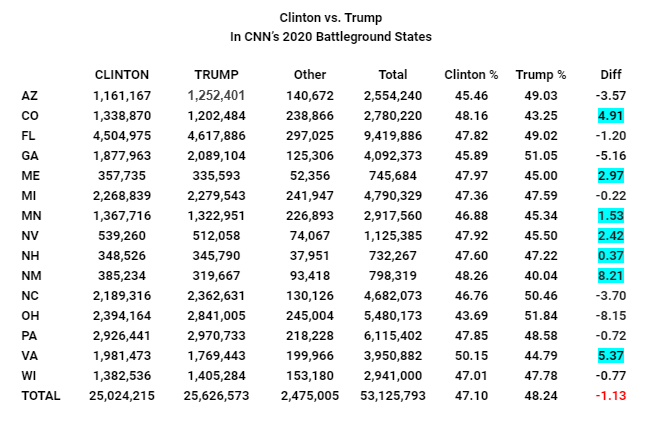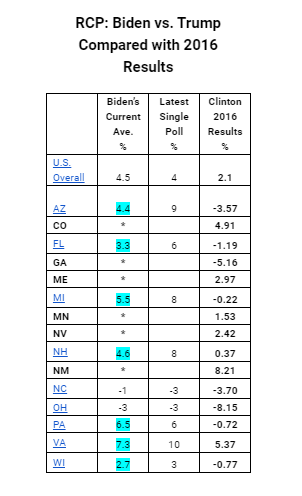
(Credit: CNN)
A new CNN poll reports Joe Biden leading Donald Trump nationally by five percentage points, but trailing Trump in the “battleground” states by seven percentage points.
Is that really plausible? Short answer: NO. The two results, taken together, are simply not credible.
In 2016, Hillary Clinton won the national vote by 2.1 percentage points. She barely lost the electoral vote, because she lost Michigan by .22%, Wisconsin by .77%, and Pennsylvania by .72% — for an average loss of .56%.
Had she won those three battleground states, she would have won the electoral vote. Going from a national lead of 2.1% to a battleground state loss of .56% is a net swing of just 2.66 percentage points. CNN would have us believe that the net swing for Biden is five times greater – from 5 points ahead nationally to 7 points behind in battleground states, a 12-point swing.
CNN’s Battleground States
To be fair, CNN’s list of battleground states is much longer than the three midwestern states that Clinton lost. In fact, that list includes fifteen states: Arizona, Colorado, Florida, Georgia, Maine, Michigan, Minnesota, Nevada, New Hampshire, New Mexico, North Carolina, Ohio, Pennsylvania, Virginia, and Wisconsin. They comprised 39% of the 2016 national vote.
So, how did Clinton fare in 2016 among CNN’s current fifteen battleground states? Based on AP data, the results show that Clinton won seven and lost eight of the states, and lost the overall vote by an average of just 1.13 percentage points.

If Biden is doing three points better than Clinton did nationally, as CNN reports, we should also expect him to be doing better in battleground states (“a rising tide lifts all boats”). Instead, CNN reports that while Biden’s national margin is 2.5 times greater than Clinton’s, he’s actually doing worse in battleground states – with a losing margin that is 4.2 times greater than Clinton’s.
Not only is this pattern counterintuitive and at odds with election history, the current poll results in several of the battleground states suggest that there is almost no way Biden could be trailing there by seven points overall.
Battleground States – Latest Polls, According to RealClearPolitics
According to RealClearPolitics’ averages, Biden currently leads Trump by 4.5 percentage points nationally, and he leads Trump in seven of the fifteen battleground states, while trailing Trump in two (see below for results in each state). There is little data for the other six states.

Note that Biden leads in Arizona, Florida, Michigan, Pennsylvania, and Wisconsin – all of which Clinton lost in 2016. Were he to actually win in those states, and also win in the states that Clinton did, Biden would win by 318 to 220 electoral votes.
It’s important to note that some of the RCP averages include polls in March and April, so there could be differences between what they show and what the current situation actually is. But there have not been wild swings in support for the two candidates, so the RCP averages – while not necessarily up-to-date – probably do provide a rough picture of how the candidates are faring in the states.
Thus, if we assume that the RCP averages are more or less on target, then for CNN to show that Biden is losing overall in those fifteen states by a margin of seven percentage points, he would have to be losing in Colorado, Georgia, Maine, Minnesota, Nevada, and New Mexico by an average of more than ten percentage points. Yet, not only is that an unlikely outcome in any one of those states, Clinton actually won in five of them – losing only in Georgia by about five percentage points. There is nothing in current polling that suggests Biden’s support in the states that Clinton won is radically lower than Clinton’s totals.
There is something fundamentally wrong with the CNN poll.
What was CNN’s problem – sample design or something else?
The poll of battleground states was part of CNN’s larger national poll of registered voters. In a normal sample size of 1,000 registered voters, the fifteen states would constitute about 350 to 400 respondents. But CNN bolstered that number by “over-sampling” in the battleground states (and under-sampling in the remaining 35 states), then weighting the overall sample to reflect the national electorate. In theory, that is an acceptable methodology for looking at the national figures. But it’s a questionable methodology for looking at the smaller sample of battleground states.
It’s important to remember that actual election results are not tabulated by battleground states, but by individual states. Biden could win enough battleground states to win the electoral vote, but still lose the overall vote in battleground states – if he happened to lose by large margins in the states where he lost. The CNN poll’s methodology does not permit such an analysis.
But even if one did want to look overall at battleground states, the CNN results are so out of line, both historically and contemporaneously, that they could be the result of faulty data adjustments made by the poll methodologists when weighting the responses in the over-sampling process.
If not a problem with the weighting, CNN’s problem could be as simple as the equivalent of a typo, a misinterpretation of a crosstab, or some other non-design problem.
Whatever the problem, it would be helpful if CNN would address these concerns.
I have written to Jennifer Agiesta, Director of the CNN Poll, for her comments. I will include them here if she responds.






